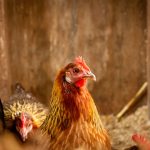Wood shavings in chicken water is a common problem for poultry owners. This issue can make the water unclean and potentially harmful if ingested by the chickens. Several factors contribute to this problem:
1.
Chicken behavior: Chickens are naturally curious and may peck at wood shavings, inadvertently causing them to fall into the water. 2. Coop activity: As chickens move around and scratch in their coop, they can kick up shavings that land in the water.
3. Waterer design: Improperly positioned or unsecured waterers can be more susceptible to contamination from wood shavings. Understanding these causes is crucial for developing effective solutions.
Addressing this issue promptly is important for maintaining the health and hydration of the flock. By implementing preventative measures, poultry owners can ensure clean water for their chickens and reduce the time and effort spent on cleaning and maintaining waterers.
Table of Contents
- 1 Choosing the Right Watering System for Your Chickens
- 2 Implementing Preventative Measures in the Coop
- 3 Using Feeders and Waterers with Anti-Spill Features
- 4 Regular Maintenance and Cleaning of the Watering System
- 5 Training Your Chickens to Keep Shavings Out of the Water
- 6 Troubleshooting and Additional Tips for Keeping Water Clean
- 7 FAQs
- 7.1 What causes wood shavings to get into chickens’ water?
- 7.2 Why is it important to keep wood shavings out of chickens’ water?
- 7.3 How can I prevent wood shavings from getting into chickens’ water?
- 7.4 Are there specific waterers that can help prevent wood shavings from getting into chickens’ water?
- 7.5 What are some other tips for keeping wood shavings out of chickens’ water?
Key Takeaways
- Wood shavings end up in the water due to chickens scratching and pecking
- Consider factors like size, material, and placement when choosing a watering system
- Preventative measures like using elevated waterers and drip cups can help keep shavings out of the water
- Anti-spill features in feeders and waterers can minimize mess and contamination
- Regular maintenance and cleaning of the watering system is crucial for keeping water clean
Choosing the Right Watering System for Your Chickens
Gravity-Fed Waterers
Gravity-fed waterers are a popular option, which use a reservoir to automatically dispense water as needed. These waterers often come equipped with anti-spill features that help prevent shavings from contaminating the water.
Nipple Waterers
Nipple waterers deliver water directly to the chickens when they peck at the nipples. This type of waterer is typically mounted at a height that prevents shavings from falling into the water source.
Heated Waterers and Other Considerations
Additionally, heated waterers are available for cold climates, which can help prevent freezing and reduce the likelihood of shavings getting into the water. When choosing a watering system, consider factors such as the size of your flock, the climate in your area, and the layout of your coop. By selecting the right watering system for your specific needs, you can significantly reduce the risk of wood shavings contaminating the water and provide your chickens with a clean and reliable water source.
Implementing Preventative Measures in the Coop

In addition to choosing the right watering system, implementing preventative measures in the coop can also help minimize the presence of wood shavings in the water. One effective strategy is to use a deep litter method in the coop, which involves adding a thick layer of bedding material such as straw or pine shavings. This helps absorb moisture and odors, while also providing a comfortable environment for the chickens.
By using a deep litter method, you can reduce the likelihood of shavings being kicked up and landing in the water. Another preventative measure is to position the waterer away from areas where chickens tend to scratch and dust bathe. Placing the waterer in a corner or against a wall can help minimize the amount of shavings that end up in the water.
Furthermore, regularly raking and smoothing out the bedding in the coop can also help prevent shavings from accumulating near the waterer. This will not only keep the coop clean and tidy but will also reduce the risk of contamination in the water source. Additionally, providing alternative sources of entertainment and enrichment for your chickens, such as hanging treats or toys, can help redirect their natural pecking behavior away from the waterer and onto more appropriate objects.
By implementing these preventative measures in the coop, you can create a cleaner and more hygienic environment for your chickens while reducing the likelihood of wood shavings ending up in the water.
Using Feeders and Waterers with Anti-Spill Features
Investing in feeders and waterers with anti-spill features can be an effective way to prevent wood shavings from contaminating the water supply for your chickens. Many modern feeders and waterers are designed with features such as raised rims or covers that help prevent shavings from falling into the water. Additionally, some waterers are equipped with filters or screens that block out debris and contaminants, ensuring that only clean water is accessible to the chickens.
By using feeders and waterers with anti-spill features, you can significantly reduce the amount of maintenance required to keep the water clean and free from shavings. Another option to consider is using hanging or suspended feeders and waterers, which can help keep them elevated and out of reach from shavings on the ground. This not only prevents contamination but also helps conserve space in the coop and reduces clutter on the floor.
Additionally, using larger capacity feeders and waterers can help minimize spillage and reduce the frequency of refilling, which can further decrease the chances of shavings ending up in the water. By investing in feeders and waterers with anti-spill features, you can effectively mitigate this issue and provide your chickens with a consistent supply of clean and uncontaminated water.
Regular Maintenance and Cleaning of the Watering System
Regular maintenance and cleaning of the watering system are essential to ensure that wood shavings do not accumulate in the water supply for your chickens. It’s important to routinely inspect and clean the waterer to remove any debris or contaminants that may have accumulated over time. This includes checking for any clogs or blockages in the dispensing mechanism and ensuring that all components are functioning properly.
Additionally, it’s crucial to regularly change out the water and refill it with fresh, clean water to prevent bacterial growth and contamination. Furthermore, cleaning the surrounding area of the waterer and removing any accumulated shavings or debris can help prevent them from falling into the water source. This can be done by sweeping or raking around the waterer regularly to keep it free from any potential contaminants.
Additionally, periodically disinfecting the waterer with a mild bleach solution or other poultry-safe disinfectant can help kill any harmful bacteria or pathogens that may be present. By maintaining a clean watering system and regularly cleaning and disinfecting it, you can ensure that your chickens have access to clean and uncontaminated water at all times.
Training Your Chickens to Keep Shavings Out of the Water

Redirecting Natural Behavior
One way to do this is by providing alternative sources of entertainment and enrichment for your chickens to redirect their natural pecking behavior away from the waterer. This can include hanging treats or toys in different areas of the coop to encourage them to peck at these items instead of around the waterer.
Positive Reinforcement and Deterrents
Additionally, using positive reinforcement techniques such as rewards or treats when they avoid pecking at shavings near the waterer can help reinforce this behavior. Another strategy is to use deterrents such as physical barriers or covers around the base of the waterer to prevent chickens from kicking up shavings into the water. This can help train them to avoid pecking or scratching near the waterer and reduce the likelihood of contamination.
Consistency and Patience
Consistency is key when training your chickens, so it’s important to be patient and persistent in reinforcing positive behaviors around the watering system. By training your chickens to keep shavings out of the water, you can create a cleaner and more hygienic environment for them while minimizing maintenance efforts on your part.
Troubleshooting and Additional Tips for Keeping Water Clean
In addition to implementing preventative measures and training your chickens, there are several troubleshooting tips and additional strategies that can help keep wood shavings out of the water supply for your flock. One common issue that may contribute to this problem is overfilling or spilling of water from the dispenser, which can lead to shavings becoming saturated and falling into the water. Ensuring that you fill the waterer to an appropriate level and avoid overfilling can help prevent this from happening.
Another tip is to regularly check for any leaks or cracks in the waterer that may be causing shavings to enter into the water supply. Repairing or replacing any damaged components can help maintain a clean and uncontaminated water source for your chickens. Additionally, providing ample space around the watering system and avoiding overcrowding can help reduce disturbances that may lead to shavings ending up in the water.
Furthermore, regularly monitoring your chickens’ behavior around the watering system can help identify any potential issues or areas for improvement. Observing their interactions with the waterer can provide valuable insights into their habits and preferences, allowing you to make necessary adjustments to minimize contamination. By troubleshooting potential issues and implementing additional tips for keeping water clean, you can effectively address this problem and ensure that your chickens have access to a consistent supply of clean and uncontaminated water.
In conclusion, wood shavings ending up in the water supply for your chickens can be a common issue with several contributing factors. By understanding why this happens and choosing an appropriate watering system, implementing preventative measures in the coop, using feeders and waterers with anti-spill features, regular maintenance and cleaning of the watering system, training your chickens, troubleshooting potential issues, you can effectively address this problem and provide your flock with a clean and uncontaminated source of hydration. With these strategies in place, you can create a healthier environment for your chickens while minimizing maintenance efforts on your part.
If you’re looking for more tips on keeping your chickens healthy and happy, check out this article on large chicken coop ideas. It’s important to provide a clean and comfortable environment for your flock, and this article offers some great ideas for creating a spacious and functional coop. Plus, a well-designed coop can help prevent issues like wood shavings getting into your chickens’ water supply.
FAQs
What causes wood shavings to get into chickens’ water?
Wood shavings can get into chickens’ water due to the chickens scratching and pecking at the bedding material in their coop, which can lead to shavings being carried into the waterer.
Why is it important to keep wood shavings out of chickens’ water?
It is important to keep wood shavings out of chickens’ water to prevent the water from becoming contaminated with debris, which can lead to health issues for the chickens.
How can I prevent wood shavings from getting into chickens’ water?
To prevent wood shavings from getting into chickens’ water, consider using a different type of bedding material, such as straw or hay, that is less likely to be carried into the waterer by the chickens.
Are there specific waterers that can help prevent wood shavings from getting into chickens’ water?
Yes, there are waterers designed with features such as a cover or a narrow opening that can help prevent wood shavings from getting into the water.
What are some other tips for keeping wood shavings out of chickens’ water?
Other tips for keeping wood shavings out of chickens’ water include placing the waterer on a raised platform, using a drip-catch tray, and regularly cleaning and maintaining the waterer to remove any shavings that may have accumulated.
Meet Walter, the feathered-friend fanatic of Florida! Nestled in the sunshine state, Walter struts through life with his feathered companions, clucking his way to happiness. With a coop that’s fancier than a five-star hotel, he’s the Don Juan of the chicken world. When he’s not teaching his hens to do the cha-cha, you’ll find him in a heated debate with his prized rooster, Sir Clucks-a-Lot. Walter’s poultry passion is no yolk; he’s the sunny-side-up guy you never knew you needed in your flock of friends!







